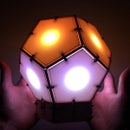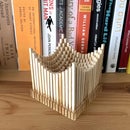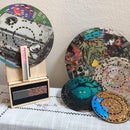Introduction: Diffraction Grating Kaleidoscope
Kaleidoscopes create impressive visual displays by simply turning a knob. Here is a great design by randofo. Colorful displays can also be created with diffraction gratings. The visuals become even more stunning when you turn one diffraction grating in front of another: here is a video with lasers. This gave me the idea to create a diffraction grating kaleidoscope that makes it easy to turn the diffraction gratings for beautiful light patterns. One thing that makes the device different than usual kaleidoscopes is that it generates different patterns depending on the light source you are looking at.
Step 1: Supply List
Materials
1. Two sheets 3mm thick 12" x 12" plywood: https://www.amazon.com/gp/product/B07H3CGLQ8/ref=p...
2. Two double axis diffraction gratings: https://www.amazon.com/gp/product/B0074R38RY/ref=p...
3. Super glue
4. Wax
Tools
1. Laser cutter
2. Scissors
Step 2: Cut the Chassis
The chassis was designed in Fusion 360 so it could be cut with a laser cutter. Layers stack together and are held in place with arms along the outside of the device. The diffraction gratings are mounted to a disc that spins in a channel within the device. Most layers have a number on them to indicate the order in which they are stacked. Use the above pdfs and a laser cutter to cut out the layers. Some of the joints and the use of wax for sliding parts was inspired by UGears designs. This idea could also be adapted for 3D printing.
Step 3: Front End Assembly
Place the three arms into the front piece with the circle design on it. Then stack the layers labeled 2-5 using the arms as guides. Rub wax onto surfaces 4 and 5 so the grating wheel can slide when it is inserted into the assembly. Finally, place the layer with the large hole onto the stack.
Step 4: Grating Wheel
Super glue the small circular layer with the rectangular hole onto the large circular layer with the rectangular clearing. NOTE: It is critical to align these two layers as best you can or else the grating wheel won't fit well into the device. Cut the edges of the diffraction grating so it will fit into the wheel assembly, then glue it onto the wood. The last step is to glue the other small circular layer with the rectangular hole onto the back. Repeat all these steps to create two grating wheel assemblies.
Step 5: Mid Section Assembly
Place one of the grating wheels into the front assembly. Add wax to any surfaces the wheel is in contact with. Stack layer 7 on top of the grating wheel and make sure that the grating wheel rotates smoothly in the assembly. Then stack layers 8-12. At this point you add the second grating wheel in the same way you did before. Layers 14 and 15 are added next.
Step 6: Rear End Assembly
Slide the rear plate with the designs over top surface 15. It will be a snug fit, so you may need to add wax. After the rear plate is in place, press the small elevating foot into the rear plate. In the final step, press the rear holding surface into the four joints on the rear surface. Your diffraction kaleidoscope is ready to go!
Step 7: Kaleidoscope in Action!
Point the diffraction grating kaleidoscope at any light source (except the sun!), and then rotate the plates using the exposed knobs. The patterns are beautiful and you will see the environment in a new light. Thanks for reading the instructable!






